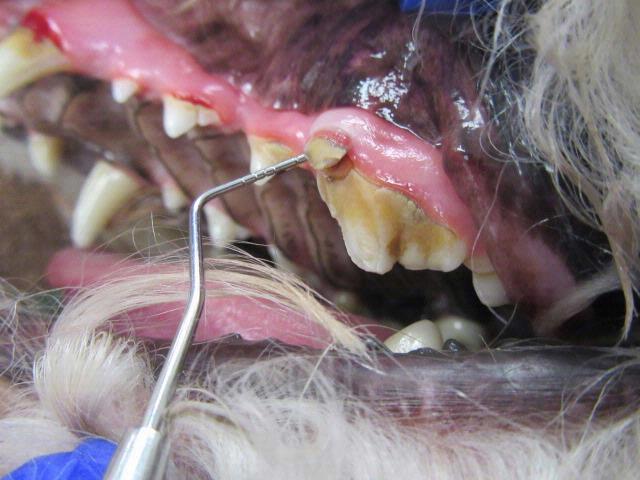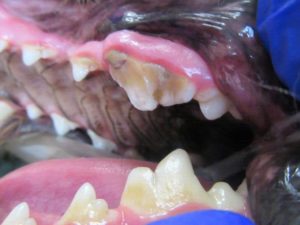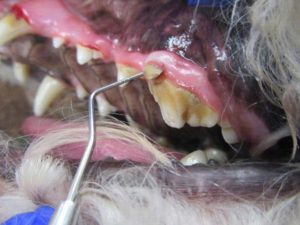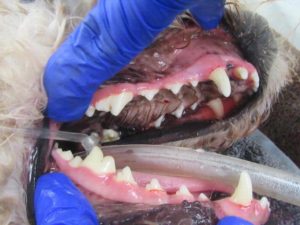
Our pet of the month for April is Clover! Clover is a Goldendoodle that loves dressing up, treats and chewies. Unfortunately, one of these caused her veterinarian to recommend surgery.
Clover was taken to her veterinarian for her routine biannual exam. She was doing great at home and was not showing any signs of being unwell.
During her exam it was found that she had fracture her maxillary carnassial tooth – that’s the largest upper chewing tooth.
Why didn’t her owners notice her broken tooth or any pain?
It is very difficult to see signs of oral pain in our pets. This doesn’t mean that they do not experience tooth pain. Most of our pet’s fractured teeth are found during routine veterinary exams, and are a surprise to their owners.
Possible signs of pain are:
- Decreased interest in eating dry food or hard treats.
- Chewing more slowly than usual.
- Dropping food from the mouth while chewing.
- Excessive drooling.
- Pawing at the mouth.
- New or worsening resistance to having the face/mouth touched.
When a tooth is first fractured it is acutely painful. The pulp cavity of the tooth contains nerves and blood vessels. When this nerve is exposed to the outside world this is extremely painful and bacteria can enter the bloodstream. Usually this pain is short lived as the exposed pulp becomes inflamed and eventually dies. At this point the nerve is not transmitting pain signals.
Now the exposed pulp canal is freely letting bacteria into the body. Eventually, a tooth root infection will form. This causes chronic pain that will fluctuate in intensity. The bacteria will also travel via the blood stream to distant organs causing damage.
All teeth that are fractured into the pulp cavity need treatment. They cannot be left even if the dog does not seem to be in pain.
How do dogs fracture their teeth?
The carnassial teeth is the large, main chewing tooth in dogs. When you see a dog chewing on a chewy, you will notice that they chew with the side of their mouth. Their carnassial teeth create a scissor like motion to sheer food into smaller pieces.
The upper carnassial tooth is the most common tooth fracture Hawthorne Hills Veterinary Hospital sees in dogs. The reason this happens is that many of the chews sold for dogs are too hard. When the dog chews on them, the dog’s tooth will break before the chew item does.
Even though is it well documented and known that certain chews will break dogs’ teeth, they are still sold and marketed most places that sell pet supplies. When you are shopping for chews for your dog, how will you know which ones are safe? There are a couple ways to find out.
The Knee Cap Rule:
“If you would not want me to hit you in the knee cap with it, do not let your dog chew on it!” For very small dogs, I say “if your dog would not want me to hit them in the knee cap with it, do not let them chew on it.” – Dr. Fraser Hale, a veterinary dental specialist from Guelph, Ontario Canada.
If you do not want to hit yourself in the knee in public, there is another way! If you can indent the chew with your thumb nail, then it should be safe and will not break your dog’s teeth.
Terrible Tooth Breaking Chews:
- Antlers
- Real Bones
- Nylabones
- Yak Milk Chew
- Hooves
- Bully Sticks
How do we treat fractured teeth?
Fractured teeth must be treated to prevent pain in our pets. There are two ways to treat broken teeth: surgical extraction or root canal.
For the maxillary carnassial teeth, root canal therapy is recommend as these teeth are large and the main teeth used for chewing. However, not every fractured tooth is a candidate for a root canal. Root canals require going to a dental specialist and are more costly than extracting the tooth. If a root canal is not an option (medically or financially) then extracting the tooth is required. In Clover’s case, her tooth had a fracture that extended below the gum line; most often, these types of fractures cannot be repaired.
Dogs do very well after tooth extraction. Remember, this tooth is painful so they are not using it to chew. Removing it removes the source of pain, leaving your pet with a pain free, happy mouth. The gingiva is very tough and pets are still able to eat their dry kibble. Clover’s fractured tooth was surgically extracted. All of her teeth were examined under anesthesia, scaled, polished and radiographed. For two weeks after the surgery she had to eat soft food and could not have toys or chews. She was rechecked two weeks post -op and her extraction site was completely healed.
Clover is now living with a happy and pain free mouth!
If you haven’t had your pet’s teeth professionally cleaned and evaluated, now is the time. Some aspects of dental disease, including broken or damaged teeth, are not visible until your pet is under anesthesia. Fully evaluating all tooth surfaces and getting dental radiographs are essential. Call us to schedule an appointment to keep your pet healthy and comfortable.
Dental Resources:
- YouTube – Fractured Teeth Require Treatment – Dr. Fraser Hale
- The Knee Cap Rule – Dr. Fraser Hale
- https://vetmed.illinois.edu/2022/02/02/treatment-options-for-fractured-teeth/
- Pulp Exposure in Dogs & Cats – Dr. Fraser Hale
- American Veterinary Dental College – Resources from Specialists
- Veterinary Oral Health Council (vohc.org)
Tooth Brushing:
- Why Brush Your Pet’s Teeth Daily – Animal Medical Center of Seattle – Dental Specialists
- How to Brush Your Pet’s Teeth – Animal Medical Center of Seattle Dental Specialists




